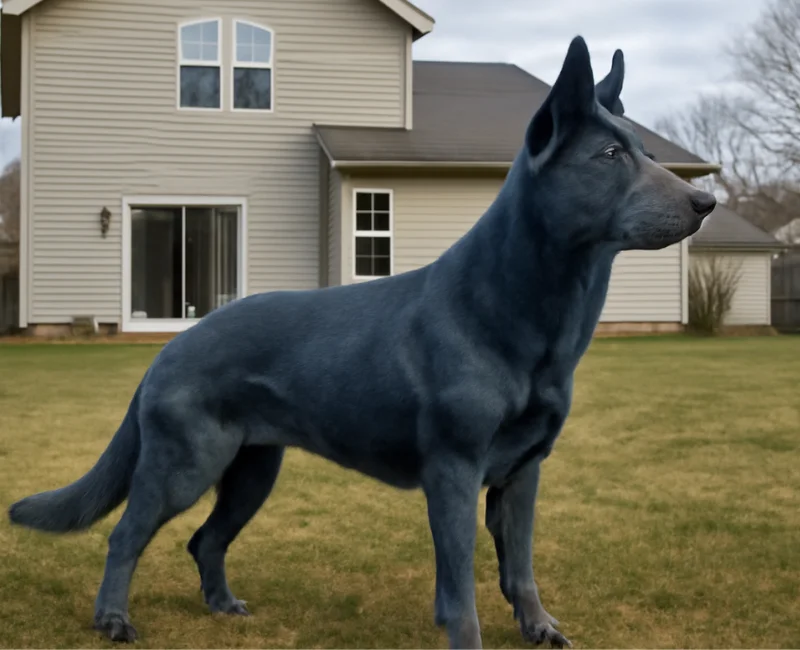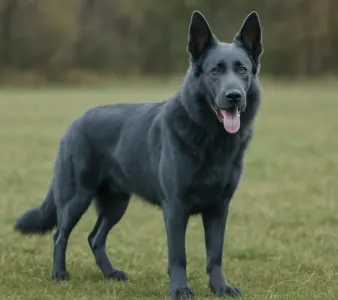What Is a Blue German Shepherd?
The Blue German Shepherd is a unique, extraordinary, and beautiful color variant of the old-style German Shepherd Dog. From the uneducated perspective, the blue German Shepherd seems to be a separate breed. Yet, it has all the same behavioral, physical, and genetic characteristics as its standard-colored equivalents. The distinctive coat color comes from a recessive dilution gene, which replaces the normal black with a lovely steel-blue or grayish tone.
These dogs have all the classic GSD traits: great intellect, unswerving loyalty, and remarkable working skills. Their unique coat distinguishes them as a more exotic variation of an already well-known breed.

Quick Outline
Trait Details
Height 24–26 inches (male), 22–24 inches (female)
Weight 65–90 pounds (male), 50–70 pounds (female)
Lifespan 9–13 years
Colors Blue (diluted black), Blue & Tan, Blue Sable
Temperament: Loyal, alert, trainable, confident
Suitable For Families, active singles, and service work
Price $1,500 – $3,500+ (from reputable breeders)
Genetics Behind the Blue Coat
You must first understand canine coat genetics to understand the blue German Shepherd. A recessive dilution gene designated as “dd” in genetic jargon modulates the breed’s famous black coloring. Usually lightened, a dog inherits this trait from both parents, produces a diluted slate-gray or silver-blue tone across the coat, paw pads, nose, and eyes.
- Inheritance: Both parents must carry the “d” gene.
- Color Range: Light silver-gray to deep charcoal blue.
- Other Physical Changes: Nose, nails, and eye rims may appear lighter.
Unlike other breeds that suffer from health conditions associated with dilute colors (such as Color Dilution Alopecia in Blue Dobermans), blue German Shepherds are not widely known to have health issues directly linked to their color. It is significant to conduct appropriate research before choosing a breeder.
Types of Blue German Shepherds
Blue GSDs can appear in several distinct patterns, depending on how the dilution gene interacts with other color traits:
Solid Blue
A uniform blue-gray coat with minimal to no other markings. This is the rarest variation.
Blue and Tan
This coat is a softer-toned take on the standard black and tan GSD. Blue replaces black, and tan stays the same.
Blue Sable
Features blue-tipped hairs with banded color patterns, giving a more dynamic, multi-tone appearance.
Each of these types maintains the same temperament and structure as standard German Shepherds. The choice ultimately comes down to visual preference.
History and Origins of the Blue GSD
Originally developed by Captain Max von Stephanitz to be the best herding and working dog, the German Shepherd breed started in Germany in the late 19th century. Believed to have had some blue-tinted offspring, the first registered GSD, Horand von Grafrath, shows the dilution gene was there from the start.
But traditionalists preferred the more prevalent black and tan colors; hence, blue GSDs were sometimes skipped in breeding projects. Fans started purposefully breeding for this unique and striking coloration much later.

Popularity and Recognition
Thanks to their service responsibilities and media appearances, German Shepherds shot to become extremely popular worldwide following World War One. But show ring criteria and breeding choices kept the blue variety under the radar.
Kennel Club Status:
- American Kennel Club (AKC): Blue is an allowed but penalized color. It’s considered a serious fault in confirmation shows.
- Recognized since 1924 with more liberal color criteria, United Kennel Club (UKC)
In summary, you can register a blue German Shepherd, but don’t count on them to excel in the show ring. These dogs are best for their service, sports, or company.
Unique Traits of Blue German Shepherds
Possible Blue or Light Eyes
Due to the dilution gene, some puppies may be born with bright blue eyes, although most will darken with age.
High Intelligence and Trainability
These dogs excel in compliance, protection, and quickness. They are quick learners and love mental inspiration.
Rarity Equals Higher Price
Due to limited gene availability, blue GSDs can be harder to find and more expensive.
Color Doesn’t Affect Behavior
Despite their rare appearance, they behave identically to other GSDs: loyal, protective, and intelligent.
May Be Prone to Alopecia (Rare)
While uncommon, color dilution alopecia (CDA) can affect some blue-coated dogs. Ask breeders about coat health history.
Are They Good Family Dogs?
Indeed, early training and socializing call for certain commitments. Blue German Shepherds can be brilliant for family and friends.
Pros:
• Loyal and protective of family
• Great with kids when raised with them
• Highly trainable and eager to please
• Adaptable to active lifestyles
Cons:
• Not ideal for first-time dog owners
• Needs extensive exercise and training
• May develop behavior issues if bored or isolated
• Protective instincts can become overbearing without socialization

Price & Availability
Blue GSDs are more expensive than standard color variants due to their rarity and selective breeding.
Source Estimated Price
Reputable Breeder $1,500 – $3,500+
Backyard Breeder (Avoid) $500 – $1,200 (poor quality)
Rescue/Shelter $200 – $500 (rarely found)
Warning: Avoid breeders focused only on color. Prioritize health testing, temperament, and ethical practices.
Health and Lifespan
Blue German Shepherds usually share the identical health profile as standard GSDs.
Common Health Issues:
• Hip and elbow dysplasia
• Degenerative myelopathy
• Allergies and skin sensitivities
• Bloat (gastric torsion)
Tips for Healthy Living:
• Schedule regular vet visits
• Feed high-quality dog food
• Provide daily exercise and training
• Ask your breeder for genetic screening results
Lifespan: 9 to 13 years with proper care
Grooming & Maintenance
German Shepherds are heavy seasonal shedders. Blue-coated variants have the same grooming needs as standard GSDs:
• Brushing: 3–5 times a week (daily during shedding season)
• Bathing: Every 4–6 weeks
• Nail Trimming: Monthly
• Ear Cleaning: Weekly
Their thick double coat will be better managed using a de-shedding tool and slicker brush. Frequent grooming also maintains the skin’s health and helps to lower shedding.
Exercise & Training Needs
Blue German Shepherds are highly demanding, physically and mentally driven working dogs:
- Daily exercise consists of 90 to 120 minutes of walking, play, or training.
- Mental stimulation includes puzzle toys, obedience exercises, and agility.
- Socialization: Early contact with people, animals, and surroundings shapes
They shine in roles including service, therapy, search and rescue, and protection.
Should You Get a Blue German Shepherd?
Experienced, energetic owners who know the demands of working dogs will find this dog perfect. A blue German Shepherd would be the ideal fit if you want a smart, beautiful, and devoted dog and are ready to do the necessary labor
Ideal For:
• Active families with older kids
• Singles or couples with time for training
• Owners looking for a protective companion
• Enthusiasts of rare and beautiful dogs
Final Thoughts
One of the most beautiful variations of a beloved breed worldwide, the Blue German Shepherd is for those ready to meet their demands. They are a unique friend because of their blend of unusual beauty and great intelligence.
Before buying or adopting, make sure to:
• Choose ethical breeders or rescues
• Understand grooming, training, and exercise needs
• Invest in socialization and healthcare
In the right home, a blue German Shepherd will not just be a pet, they will be a family.
